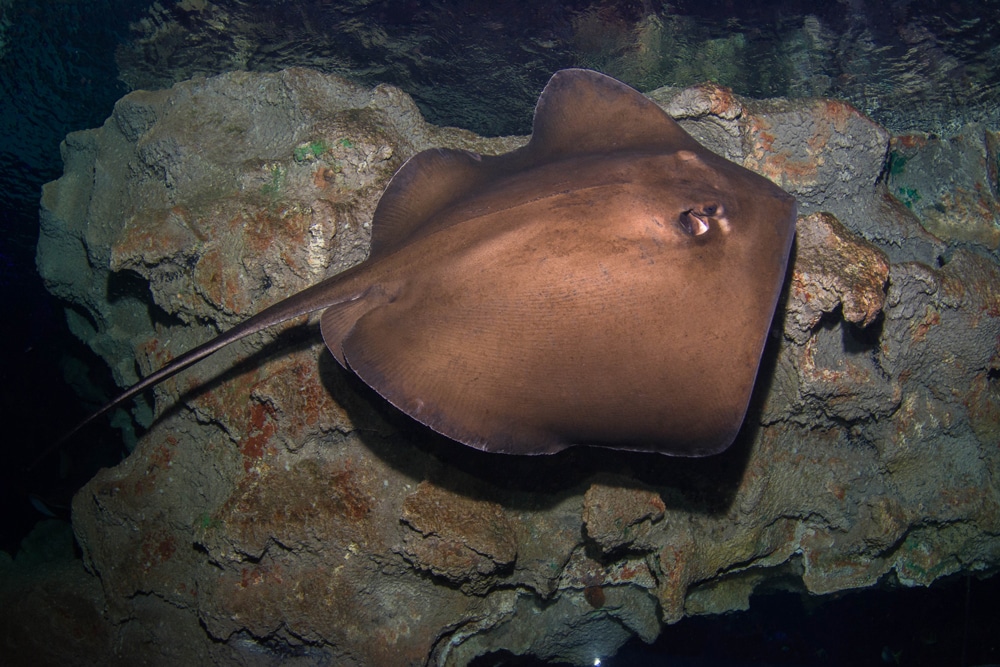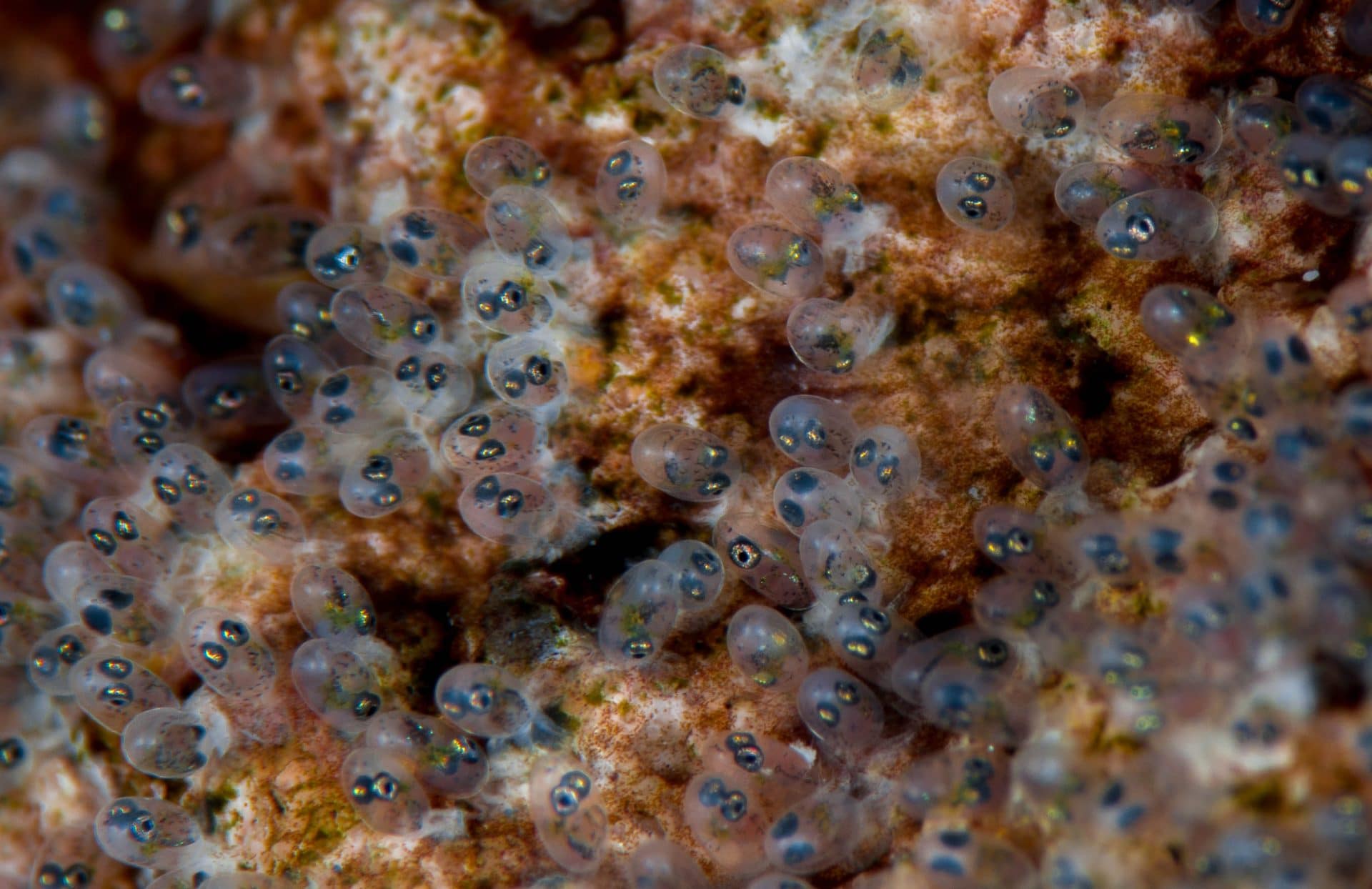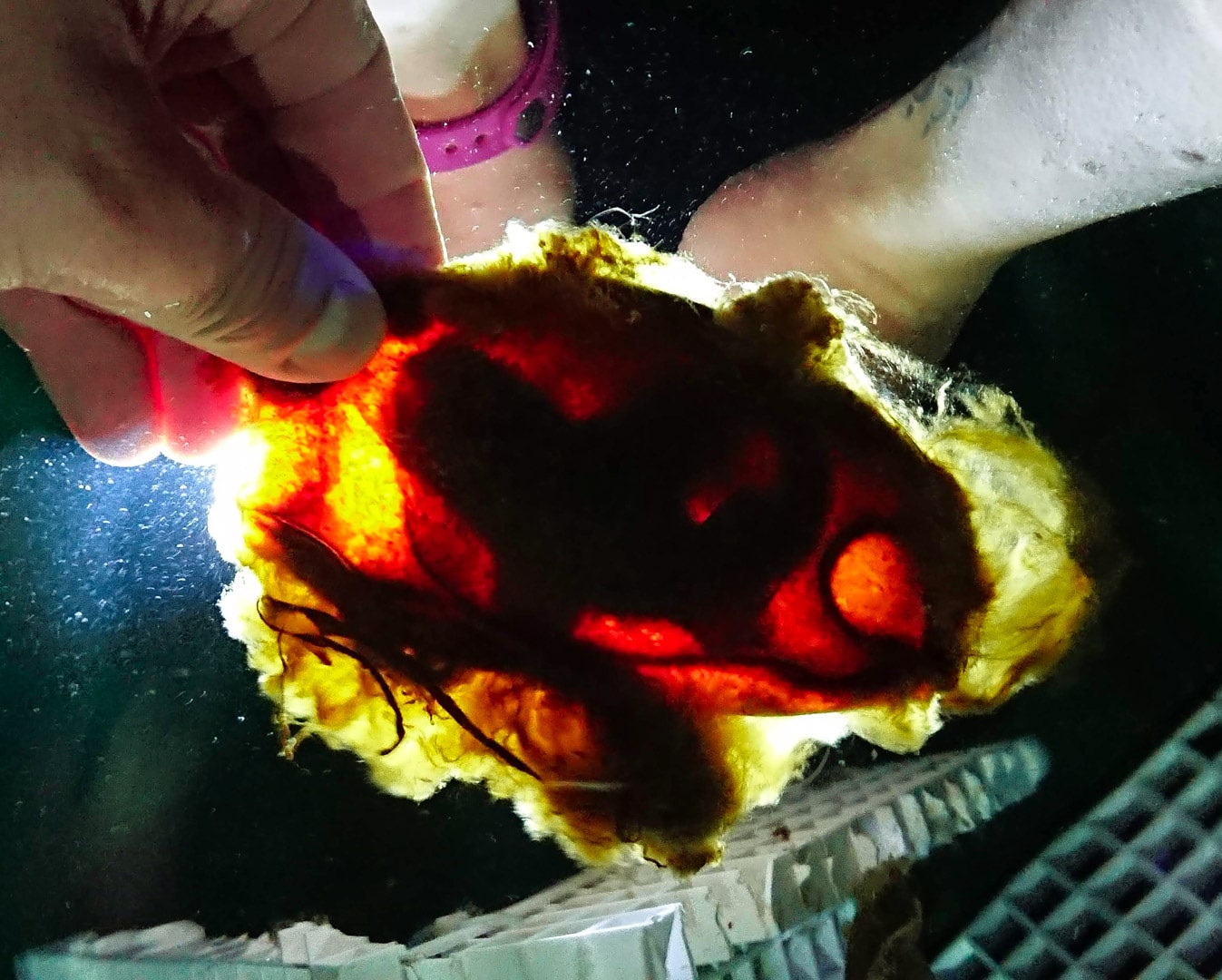Marine Life & Conservation Blogs
Breeding at Blue Planet

Breeding in the main tank at Blue Planet
Here at Blue Planet Aquarium we have many animals that live in our main tank, everything from our Sand Tigers all the way down to our Goliath Grouper. But there are a few animals in our main tank that breed on a more than Regular basis. In this article we are going to talk about three of them.
The first one is instantly recognisable as it is one of our signature animals, the Southern Atlantic Stingray. This species can grow up to nearly 5 feet across, with males being significantly smaller at around 2 feet across. Here at Blue Planet we have six adult stingrays, one male and five females with many of their offspring in a separate section of the tank. There are two main females who are breeding, and their names are “Big Bertha” and “Greedy” and we usually expect a litter from each between July and August, this can be anything between 2 – 6 pups on average per litter.
When we find pups in the tank we immediately drop whatever task we’re doing at the time and grab the ray nets (a specially designed flat net that can zip-up) in order to catch them. Every time we catch a pup we will keep going back into the tank until we’re satisfied that all pups have been captured. In the immediate days following the initial birth we will keep our eyes out for any other pups that may appear during the next few days.
Once captured the animals are placed in quarantine which is separate from the main exhibit. They’re kept here for around 6 weeks just so they get used to hand feeding and so that they can grow slightly before they go into the reef section, which is a smaller section of the main tank away from the larger sharks. The animals are kept until they’re large enough to either be moved to a different collection or go on display.
The next animal is probably the least noticed by our guests, it’s a small fish called a Sergeant-Major Damselfish. In the last year we’ve had an unbelievable number of clutches of such a vast amount that we’re finding new nests every day. The way in which they breed is quite fascinating.
Sergeant-Major Damselfish males lure females in with audio cues and “Signal Jumping” – this is where the male will swim erratically up and down, once the female has been attracted they will both change from their light blueish-green colour and turn almost completely dark blue until you can barely see their stripes, and males will develop a bright white patch on his cheek.
The female will lay up to 20,000 eggs and apparently there can be up to four females that add to any one clutch. Both males and females perform a kind of Ballet when laying eggs as they spin around with a head to tail position and then the female breaks away to deposit her eggs and as she finishes a clutch the male descends to fertilise them, this happens until all the eggs have been laid. The eggs are laid to the side of rocks and corals, usually on the roof of overhangs to maximise protection.
Males will guard their clutch ferociously and are now known by the dive team as the most aggressive animal in the tank; they’ve even been seen attacking the Sand Tigers (even though it doesn’t seem to bother them). Males will then spend the next 5-7 days of the gestation period constantly guarding and aerating them to stop fungus from settling on the eggs which would kill them, and just before hatching the eyes on the larvae turn a green colour.
Unfortunately due to the nature of the tank and larvae, we are still trying to figure out how we can harvest the fry to rear them in quarantine but unfortunately you need to be there at the moment they hatch and that usually happens at night. We have placed terracotta tiles in the tank to try and entice them to lay eggs on them so that they can be harvested. Even though we’re still trying to figure out how to harvest them it appears nature is best as we’ve actually seen young fish thriving in the main exhibit.
The final animal is the most cryptic of them all and this is of course Bamboo Sharks. These Sharks spend most of their days sleeping in caves, holes and under overhangs; they’re shy until feeding time and then they’re our best friends. This Shark species lays eggs called “Egg cases/Mermaids Purses” and they lay their eggs around stems of coral or around rockwork. They do this by swimming very quickly over rockwork until the threads of the egg “hook” onto the rocks or coral and then they immediately swim quickly around in big circle causing the egg to slowly be pulled out and wrapped up against the piece of rockwork.
Now this is where the egg would stay if we didn’t find it, but once we find an egg we check them by “candling the egg” which is simply holding up to the light or shining a torch through it; if we see a yolk then it’s a viable egg. There are times we do this and see a shark pup still developing inside which is always a true joy to see. Once we’ve checked the egg is viable, we remove it and place it in our Shark hatchery to develop. The gestation period is usually around 4-5 months, but we check the progress by candling them just to monitor how they’re doing. When they hatch, they have very striking black and white stripes which are used to mimic White-Banded Sea Snakes, as these snakes in their native Indian Ocean habitat would be avoided by most predators (Zebra Sharks also use this form of mimicry). The pups stay in the hatchery until they’re around 10-12 inches long and are trained to feed from your hands and then we move them to another collection.
So, there you have it: Three amazing animals that breed in just our main tank exhibit alone. We do have many other breeding projects here at Blue Planet Aquarium which I’ll be covering in future blog posts.
For more information please visit the Blue Planet Aquarium website by clicking here.
Follow Donovan on Instagram at www.instagram.com/donovans_reefs
Marine Life & Conservation Blogs
Creature Feature: Dusky Shark

 In this series, the Shark Trust will be sharing amazing facts about different species of sharks and what you can do to help protect them.
In this series, the Shark Trust will be sharing amazing facts about different species of sharks and what you can do to help protect them.
This month we’re taking a look at the Dusky Shark, a highly migratory species with a particularly slow growth rate and late age at maturity.
Dusky sharks are one of the largest species within the Carcharhinus genus, generally measuring 3 metres total length but able to reach up to 4.2 metres. They are grey to grey-brown on their dorsal side and their fins usually have dusky margins, with the darkest tips on the caudal fin.
Dusky Sharks can often be confused with other species of the Carcharhinus genus, particularly the Galapagos Shark (Carcharhinus galapagensis). They have very similar external morphology, so it can be easier to ID to species level by taking location into account as the two species occupy very different ecological niches – Galapagos Sharks prefer offshore seamounts and islets, whilst duskies prefer continental margins.
Hybridisation:
A 2019 study found that Dusky Sharks are hybridising with Galapagos Sharks on the Eastern Tropical Pacific (Pazmiño et al., 2019). Hybridisation is when an animal breeds with an individual of another species to produce offspring (a hybrid). Hybrids are often infertile, but this study found that the hybrids were able to produce second generation hybrids!
Long distance swimmers:
Dusky sharks are highly mobile species, undertaking long migrations to stay in warm waters throughout the winter. In the Northern Hemisphere, they head towards the poles in the summer and return southwards towards the equator in winter. The longest distance recorded was 2000 nautical miles!
Very slow to mature and reproduce:
The Dusky Shark are both targeted and caught as bycatch globally. We already know that elasmobranchs are inherently slow reproducers which means that they are heavily impacted by overfishing; it takes them so long to recover that they cannot keep up with the rate at which they are being fished. Dusky Sharks are particularly slow to reproduce – females are only ready to start breeding at roughly 20 years old, their gestation periods can last up to 22 months, and they only give birth every two to three years. This makes duskies one of the most vulnerable of all shark species.
The Dusky Shark is now listed on Appendix II of the Convention on the Conservation of Migratory Species (CMS), but further action is required to protect this important species.
Scientific Name: Carcharhinus obscurus
Family: Carcharhinidae
Maximum Size: 420cm (Total Length)
Diet: Bony fishes, cephalopods, can also eat crustaceans, and small sharks, skates and rays
Distribution: Patchy distribution in tropical and warm temperate seas; Atlantic, Indo-Pacific and Mediterranean.
Habitat: Ranges from inshore waters out to the edge of the continental shelf.
Conservation status: Endangered.
For more great shark information and conservation visit the Shark Trust Website
Images: Andy Murch
Diana A. Pazmiño, Lynne van Herderden, Colin A. Simpfendorfer, Claudia Junge, Stephen C. Donnellan, E. Mauricio Hoyos-Padilla, Clinton A.J. Duffy, Charlie Huveneers, Bronwyn M. Gillanders, Paul A. Butcher, Gregory E. Maes. (2019). Introgressive hybridisation between two widespread sharks in the east Pacific region, Molecular Phylogenetics and Evolution 136(119-127), https://doi.org/10.1016/j.ympev.2019.04.013.
Marine Life & Conservation Blogs
Creature Feature: Undulate Ray

 In this series, the Shark Trust will be sharing amazing facts about different species of sharks and what you can do to help protect them.
In this series, the Shark Trust will be sharing amazing facts about different species of sharks and what you can do to help protect them.
This month we’re looking at the Undulate Ray. Easily identified by its beautiful, ornate pattern, the Undulate Ray gets its name from the undulating patterns of lines and spots on its dorsal side.
This skate is usually found on sandy or muddy sea floors, down to about 200 m deep, although it is more commonly found shallower. They can grow up to 90 cm total length. Depending on the size of the individual, their diet can range from shrimps to crabs.
Although sometimes called the Undulate Ray, this is actually a species of skate, meaning that, as all true skates do, they lay eggs. The eggs are contained in keratin eggcases – the same material that our hair and nails are made up of! These eggcases are also commonly called mermaid’s purses and can be found washed up on beaches all around the UK. If you find one, be sure to take a picture and upload your find to the Great Eggcase Hunt – the Shark Trust’s flagship citizen science project.
It is worth noting that on the south coasts, these eggcases can be confused with those of the Spotted Ray, especially as they look very similar and the ranges overlap, so we sometimes informally refer to them as ‘Spundulates’.
Scientific Name: Raja undulata
Family: Rajidae
Maximum Size: 90cm (total length)
Diet: shrimps and crabs
Distribution: found around the eastern Atlantic and in the Mediterranean Sea.
Habitat: shelf waters down to 200m deep.
Conservation Status : As a commercially exploited species, the Undulate Ray is a recovering species in some areas. The good thing is that they have some of the most comprehensive management measures of almost any elasmobranch species, with both minimum and maximum landing sizes as well as a closed season. Additionally, targeting is entirely prohibited in some areas. They are also often caught as bycatch in various fisheries – in some areas they can be landed whilst in others they must be discarded.
IUCN Red List Status: Endangered
For more great shark information and conservation visit the Shark Trust Website
Image Credits: Banner – Sheila Openshaw; Illustration – Marc Dando
-

 News3 months ago
News3 months agoHone your underwater photography skills with Alphamarine Photography at Red Sea Diving Safari in March
-

 News3 months ago
News3 months agoCapturing Critters in Lembeh Underwater Photography Workshop 2024: Event Roundup
-

 Marine Life & Conservation Blogs3 months ago
Marine Life & Conservation Blogs3 months agoCreature Feature: Swell Sharks
-

 Blogs2 months ago
Blogs2 months agoMurex Resorts: Passport to Paradise!
-

 Blogs2 months ago
Blogs2 months agoDiver Discovering Whale Skeletons Beneath Ice Judged World’s Best Underwater Photograph
-

 Gear Reviews3 weeks ago
Gear Reviews3 weeks agoGEAR REVIEW – Revolutionising Diving Comfort: The Sharkskin T2 Chillproof Suit
-

 Marine Life & Conservation2 months ago
Marine Life & Conservation2 months agoSave the Manatee Club launches brand new webcams at Silver Springs State Park, Florida
-

 Gear Reviews3 months ago
Gear Reviews3 months agoGear Review: Oceanic+ Dive Housing for iPhone

























